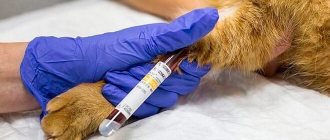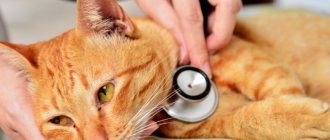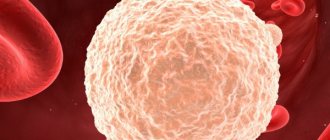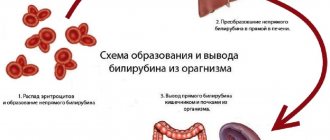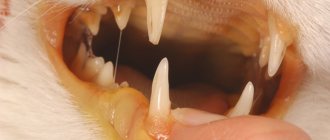5228Pavel
Alkaline phosphatase enzyme activity occurs mostly in the liver, but also in the intestines and to a small extent in bone tissue. In a healthy animal, the total ALP activity in the blood consists of bone and liver isoenzymes. The second reason for increased levels of alkaline phosphatase in the blood of animals is cholestasis or cholangitis. This is a disease in which the secretion of bile slows down and the production of the enzyme increases. Diagnosis of this pathology is problematic, since alkaline phosphatase is present in the blood of cats for only a few hours and then disintegrates. Therefore, veterinarians do not consider ALP as a marker of cholestatic disease.
The second subtype of hepatic isoenzyme rises as a result of the cat taking corticosteroid substances during drug therapy. Another reason is the presence of hyperadrenocorticosis.
© shutterstock
The isoenzyme that is responsible for the activity of alkaline phosphatase in the intestinal tract is located in the thin section. Little research has been carried out in this direction, therefore, when the level of alkaline phosphatase in the intestines changes, they speak with caution about gastrointestinal diseases, and additional research is being carried out.
Increased phosphoric acid metabolism in a cat may indicate hyperthyroidism. This is a hormonal disease that causes an increase in thyroid function. Other liver enzymes are tested to make a diagnosis.
Alkaline phosphatase is elevated in liver diseases, including cirrhosis, necrosis of liver tissue, cancer, infectious and toxic hepatitis, drug-induced hepatitis, and tuberculosis. The activity of the enzyme increases with infarction of the kidneys and lungs, Cushing's syndrome, taking antibiotics, vitamin C, sulfonamide, and bacterial gastrointestinal infections.
In cats, ALP is active in the third trimester of pregnancy, when the fetus and placenta are actively growing. This is a physiological change in the enzyme that does not require treatment.
Alkaline phosphatase activity in cats
The coefficient may increase due to the development of a disease such as cholestasis.
The activity of these enzymes depends on many diseases in different body systems.
The coefficient increases with the development of a pathology such as cholestasis , due to an increase in enzyme production. Often, an increase in indicators can be caused by diseases that have nothing to do with the functioning of the liver, gallbladder or biliary tract.
Young and old cats
- A similar phenomenon can be observed in young animals, at the beginning of the formation of bones, cartilage , and skeletal structure.
- In old cats, increased phosphatase activity is observed as a result of orthopedic diseases .
Hyperparathyroidism
An in-depth blood test will help identify cholestasis in your pet.
An increase in alkaline phosphatase will manifest itself as a result of hyperparathyroidism.
There are four main isoenzymes. The first begins in the intestines of the animal, the second - in the bones and bone tissues, the remaining two isoenzymes - in the parenchymal cells of the liver.
Those that are localized in the liver, in turn, are divided into two types, depending on the effect. The coefficient of one rises due to the use of corticosteroid substances or due to the presence of hyperadrenocorticosis. An increase in another hepatic isoenzyme directly indicates the presence of cholestasis.
In cats, serum alkaline phosphatase levels are somewhat different from those of other animals , such as dogs.
For this reason, an in-depth study of blood and urine , and the level of bilirubin and gamma-glutamine transferase should be additionally calculated.
Relatively low rates are not a 100% guarantee of the absence of cholestasis. The physiological coefficient is approximately twenty to one hundred units per liter.
What to do if alkaline phosphatase is elevated?
Proper treatment and care for the animal will help get rid of the disease.
It is clear that when a disease occurs, it must be treated. After undergoing a clinical examination and identifying pathology in your pet, you need to find out more information about this disease and learn how to properly care for the animal during treatment.
Cholestasis
The animal needs immediate care and treatment. The consequences may be irreversible!
A disease associated with dysfunction of the liver and gallbladder is cholestasis.
The mechanism for the appearance of pathology is the impossibility of removing bile into the lumen of the duodenum, as a result of which it stagnates in the bladder itself and its pathways and is subsequently absorbed into the blood, thereby giving rise to a difficult process - cholemia . As a result of severe toxicity of bile, severe poisoning of the entire body occurs. If action is not taken immediately, the cat will die.
Symptoms
Externally, a sick cat does not differ from its healthy counterparts.
The signs of this disease are very extensive and contradictory, due to the variety of causes of its occurrence.
- The cat may be overly sleepy, refuse to eat, or, conversely, experience insatiability.
Excessive sleepiness of the pet should alert the owner.
A cat's weight loss can also be an alarming symptom!
Treatment
Treatment depends on the causes of the disease.
- Neoplasms and echinococcal blisters are eliminated surgically.
Treatment and prevention of elevated phosphatase in cats
To select the right food for your cat, you should contact your veterinarian.
The prognosis depends on the timeliness of treatment measures. In most cases it is favorable. An indispensable condition for the effectiveness of treatment is proper nutrition.
It is recommended to switch the animal to ready-made food containing all useful vitamins and microelements, properly balanced. It is necessary to limit the activity of a kitten with fractures by placing it in a cage for about two months. It is recommended to use painkillers, injections of calcium preparations, intravenous infusion is acceptable.
To avoid recurrence, you should treat your pet carefully, limiting too active games and being in dangerous places. Feed according to your doctor's recommendations .
Alkaline phosphatase is produced and localized in the cytoplasm of cats. This is a complex of enzymes that is found in small quantities in almost every tissue of internal organs, but mainly affects bone tissue and liver cells, and is also responsible for the formation of the placenta during pregnancy. Next, we will take a closer look at the main reasons for increased alkaline phosphatase in cats.
What is ALP
The term alkaline phosphatase (ALP) implies that all enzymes that have phosphatase activity exhibit maximum efficiency under alkaline conditions (that is, at a pH of 8.6 to 10.1), therefore alkaline phosphatase is not active in the blood and is normally found in minimal quantities.
The presence of alkaline phosphatase is noted in many tissue and organ structures of the body. However, the largest “reserves” of this enzyme are observed in:
- osteoblasts;
- hepatocytes;
- nephrocytes;
- small intestine;
- placenta;
- mammary gland during lactation.
Normal alkaline phosphatase levels
To obtain the most correct results, blood sampling should be done on an empty stomach from a vein. Blood serum is used for the study. The standard period for completing the study is one day.
In adult men, normal values range from 40 to 130 IU/l, and in women from 35 to 105 IU/l.
Causes of elevated alkaline phosphatase in cats
1. Cholestasis is the first cause of elevated alkaline phosphatase in cats. This is a disruption of the liver and gallbladder.
2. Hyperparathyroidism is a pathology of the thyroid gland in which it produces an excess amount of hormones.
3. Hereditary factor. A tendency to liver or thyroid diseases can be passed on from parents to the next generation.
4. Chronic or acute liver diseases, such as hepatitis, cirrhosis, tissue necrosis or cancer.
5. Alkaline phosphatase in cats may increase due to tuberculosis.
6. Diseases of the musculoskeletal system, for example, bone cancer.
7. Some medications also increase alkaline phosphatase in cats.
Alkaline phosphatase is an active enzyme that helps a healthy animal with digestion. Likewise, it maintains the stability of processes in bone tissue. Moreover, alkaline phosphatase cannot exist in a free form, but only in combination with hepatocyte microsomes. It is present in small amounts in most organs of the animal.
But what if alkaline phosphatase is elevated in a cat and what does this mean for the pet? Let's try to figure it out below.
Indications and analysis
Veterinarians recommend blood biochemistry if the following symptoms are present:
- frequent fractures without physical activity;
- yellowness of the mucous membranes and sclera;
- vomiting bile;
- shortness of breath, difficulty breathing;
- heart rhythm disturbance;
- intestinal disorder;
- temperature increase;
- prolonged lack of appetite;
- lethargy, refusal to play;
- change in color of stool and urine;
- soreness in the body, in which the cat does not allow itself to be touched;
- lameness without injury to the limb, swelling of the joints.
Before taking blood from a fluffy, you should shave the fur on his paw.
Testing for hormones or alkaline phosphatase should be done on an empty stomach, without allowing the animal to eat 10-12 hours before the test. Drinking water is allowed, otherwise dehydration will occur, which will distort the results. Conducting research:
- The fur on the skin is shaved.
- A tourniquet is applied to the front paw above the elbow so that the veins swell slightly.
- The injection site is treated with an antiseptic.
- A needle is inserted into a vein and the required amount of blood is drawn.
- The puncture is lubricated with alcohol.
Causes
One of the main reasons for an increase in the enzyme is diseases such as cholestasis and cholangitis. Pathologies are characterized by a decrease in the volume of bile produced.
ATTENTION! In practice, it is quite difficult to use the values of ALP in the biochemical composition of blood to determine diseases, since the latter decomposes quite quickly, within a few hours.
The second reason is long-term use of corticosteroid drugs during rehabilitation after surgery. Kittens are characterized by an increase in alkaline phosphatase during the period of strengthening bone tissue. In older cats, the level of the enzyme changes depending on the orthopedic diseases they have suffered.
Why is alkaline phosphatase low?
In contrast to elevated enzyme levels, decreased alkaline phosphatase is detected quite rarely.
In women, such changes in tests may be due to the use of oral contraceptives (however, they can also lead to stagnation of bile, and then alkaline phosphatase increases).
During pregnancy, a decrease in the enzyme is determined with the development of placental insufficiency.
Other reasons for a decrease in alkaline phosphatase in the analysis are:
- congenital hypothyroidism;
- congenital chondrodystrophy;
- deficiency of vitamin C, Mg and Zn;
- overdose of vitamin D;
- hypothyroidism;
- severe anemia and conditions after blood transfusions;
- kwashiorkosis (a severe form of dystrophy that develops as a result of prolonged protein deficiency in the diet).
Cardiovascular causes of decreased alkaline phosphatase in tests
A decrease in alkaline phosphatase can be detected with left ventricular hypertrophy that develops against the background of metabolic syndrome.
Also, similar changes in analyzes are observed in patients after bypass surgery.
Dislocation of alkaline phosphatase in the cytoplasm of cats. It is not present as a free enzyme, but interacts with hepatocyte microsomes. Simply put, this is a whole complex of enzymes, which is found in almost the entire body in small quantities, but mainly affects parenchymal liver cells, bone tissue, and also takes part in the formation of the placenta during gestation.
Cholestasis
The disease is characterized by disruption of the liver and gallbladder. At the first stage, bile ceases to be excreted into the duodenum. Of course, not immediately, but every day more and more secretions remain in the gallbladder.
Stagnation of bile occurs and it is gradually absorbed into the blood. Internal intoxication of the body occurs. Cholemia develops, which is fraught with the most tragic consequences for the cat. Let us note the main symptoms that will help owners identify impending cholestasis:
- Partial or complete refusal to eat, the animal does not even touch its favorite treats.
- The animal sleeps more often and avoids contact with family members.
- The mucous membranes turn yellow;
- Urine acquires a sharp, unpleasant odor and becomes significantly darker.
- Vomit.
- The feces are mostly liquid, with a white coating, mostly light in color.
- Kidney failure develops.
The veterinarian chooses the treatment independently. It depends on the cause of the disease. Benign tumors that can form during stagnation are removed surgically . Pathogenic microorganisms are destroyed by antibiotics. Drugs are often used in parallel to thin the bile.
Hyperparathyroidism
Problems arise when the thyroid gland begins to produce too much hormone. An imbalance is created in the body, the functioning of many organs is disrupted. Among the main reasons, experts note feeding with cheap food, fried, spicy and any food from the human table. Oddly enough, excessive consumption of fish will also lead to hyperparathyroidism.
ATTENTION! For prevention purposes, it is worth balancing your cat’s diet. Eliminate foods rich in phosphorus as much as possible and add foods high in calcium (eggs or a little milk) to your diet.
Other reasons include a genetic predisposition to calcium absorption disorders or an overly active kitten's mouth. For diagnostic purposes, the radiography method is used . A comprehensive blood and urine test is performed. As you know, a lack of calcium leads to problems with bone tissue. For better results, the entire animal is examined.
The test results show areas where bone tissue is difficult to distinguish from muscle tissue. X-rays can help identify areas where bones have become thinner and their overall density has been reduced.
External signs include:
- low mobility;
- unsteadiness of gait;
- frequent problems with bone fractures.
As mentioned above, it is difficult to judge problems only by deviations of alkaline phosphatase in one direction or another. Additional information about bilirubin and gamma-glutamine stransferase levels is often required. Judging by the norm of the enzyme, its indicators range from 39 to 55 units.
Blood chemistry
For the owner, it is important, if not to understand, then at least to navigate the abundance of enzymes and substances that will tell you about the current state of the animal. Of course, a detailed diagnosis will be carried out by a specialist, but an owner who cares about the health of the pet should show interest in the treatment process.
Let us note the main indicators that are taken into account in the blood test:
- Bilirubin. One of the main substances that make up bile. The substance is also involved in the coloring of blood. Its excess leads to changes in skin color and says a lot about liver disease (hepatitis) or problems with the bile ducts. Deficiency leads to bone marrow damage. The norm for an adult animal is 3-12 units.
- Urea. The external factor of many diseases is excessive urination, change in color and odor. An abundance of urea indicates blockage of the urinary tract and poor kidney function. But it is important to understand that excess discharge can be associated with diet. Problems arise when feeding foods rich in animal protein. The norm for an adult animal is 5-12 units.
- Glucose. Excess sugar in the body is the cause of a variety of diseases. For example, diabetes mellitus, the release of adrenaline into the blood during frequent, excessive exercise or stress. Experts also note problems with the kidneys, liver, and pancreas. Glucose levels drop during poisoning, prolonged fasting or excess alcohol. The norm for an adult animal is 3-6 units.
- Phosphorus. Increased levels are typical for animals with leukemia or bone tumors. Other causes include excess vitamin D and kidney failure. What is interesting is that long-term diarrhea leads to a decrease in phosphorus levels. The norm for an adult animal is 1-2.3 units.
- Calcium. The microelement increases due to severe dehydration, damage to bone tissue by cancer and excess vitamin D. Problems with kidneys, pancreatitis and vitamin D deficiency, calcium levels drop rapidly. The norm for an adult animal is 2-2.7 units.
- Total protein. Excessive vomiting and prolonged diarrhea contribute to increased levels of the substance. This also includes dehydration. A sharp decline in total protein is observed with intestinal diseases, cirrhosis, hepatitis, renal failure and prolonged fasting. The norm for an adult animal is 54-77 units.
As you can see, it is not only the indicators of alkaline phosphatase or amylase that you should pay attention to. Only a comprehensive analysis and competent processing of results will make it possible to prescribe an effective course of treatment.
Dangerous deviations in indicators in a cat
Deviations from the norm (increased or decreased) indicate that a malfunction has occurred in the body. Monitoring allows you to timely identify the development of the disease and begin treatment.
Bilirubin
Bilirubin is part of bile.
Bilirubin colors the blood, so an increased amount of it leads to discoloration of the skin (jaundice).
An overestimated value indicates the development of liver diseases (hepatosis, hepatitis), as well as blockage of the bile ducts.
Scheme of bilirubin formation in the blood
A decrease in bilirubin levels is observed with anemia and bone marrow lesions.
Total protein
An increase is observed with dehydration due to vomiting and diarrhea. A decrease in protein levels is typical for intestinal diseases, chronic liver diseases (cirrhosis or hepatitis), renal failure, and fasting.
Proteins are involved in all metabolic processes in the body.
Protein synthesis
Creatinine
An increase in blood creatinine levels may indicate the development of hyperthyroidism or kidney failure. A decrease in this value is observed during protein starvation.
Elevated levels of creatinine in both urine and blood indicate that the cat's diet contains a lot of animal protein.
Urea
An increase in urea indicates impaired kidney function and blockage of the urinary tract. Also, an excess of this value is observed when feeding your pet food rich in animal protein.
Uric acid crystals under a microscope
A decrease in urea indicates intestinal dysfunction, liver pathologies or protein deficiency in the diet.
Glucose
The reasons for increased blood glucose are as follows:
- Cushing's syndrome;
- diabetes;
- release of adrenaline into the blood due to increased physical activity or severe stress;
- chronic kidney or liver diseases;
- pancreatitis;
- pancreatic tumors.
A decrease in value is observed with an overdose of insulin, prolonged fasting, poisoning with poisons or alcohol.
Blood glucose
Low glucose levels are also characteristic of pancreatic diseases.
Amylase
An increase in the rate is observed in the following diseases: pancreatitis, diabetes mellitus, peritonitis, volvulus, renal failure.
Also, a high level of amylase indicates intoxication of the body due to poisoning.
Amylase
A decrease in the indicator may be the result of taking anticoagulants, poisoning, or necrosis of pancreatic tissue. The analysis determines total amylase and pancreatic amylase. The norm is 500-1200 units/l.
Cholesterol
An increase in cholesterol levels is typical for pancreatitis, diabetes mellitus, hypothyroidism and kidney disease.
Deficiency is observed with the development of malignant neoplasms, impaired absorption of nutrients in the intestines, and unbalanced nutrition.
Cholesterol in the blood
AST and ALT
An increase in these indicators indicates the destruction of liver cells, which was caused by cirrhosis, hepatitis or other diseases. Also, an increase in AST and ALT can be a consequence of injury or heart failure.
A simultaneous decrease in AST and an increase in ALT indicates the development of infectious hepatitis.
Alkaline phosphatase
Increased alkaline phosphatase can occur in pregnant animals and in pets that eat fatty foods.
A high rate is also typical for bacterial infections of the intestines and stomach, and liver diseases.
A decrease in the level of alkaline phosphatase is observed with anemia, vitamin C deficiency, and long-term use of corticosteroids.
Alkaline phosphatase is a whole complex of enzymes that is found almost throughout the body in small quantities.
Phosphorus
An increase in phosphorus is characteristic of leukemia and bone tumors. Also, a high value is observed in renal failure, hypervitaminosis of vitamin D, and disorders of the endocrine system.
Phosphorus deficiency can result from a lack of growth hormone and vitamin D.
Long-term diarrhea also leads to a decrease in the indicator.
Calcium
An increase in calcium is typical for:
- dehydration;
- destruction of bone tissue due to cancer;
- excess vitamin D.
Calcium deficiency is observed with pancreatitis, lack of vitamin D, taking anticonvulsants, and chronic renal failure.

